An Improved Directional Relay Adapted to a Distribution Network with IIG Integration
Abstract
:1. Introduction
- A high-impedance ground fault, which may result in difficulties with identifying the direction of the fault;
- A change in the reactive power output of inverter-interfaced generators (IIGs), which may cause the mal-operation of the traditional directional overcurrent relay.
- The operation zone is divided into a sensitive area and an insensitive area;
- An auxiliary criterion based on current amplitude comparison is added. If the result of the phase comparison is located in the insensitive area, then direction of the fault is further determined according to the result of the current amplitudes comparison.
2. The Principle of the Directional Relay Based on the PSFC and Its Adaptability
2.1. The Principle of the Directional Relay Based on the PSFC
2.2. Control Strategy and Fault Characteristics of the IIG
2.3. The Effect of IIG Fault Characteristics on the Directional Relay
3. Improved Directional Relay Based on an Operation Zone Partition and a Current Amplitude Comparison
- The operation zone is divided into a sensitive area and an insensitive area (Section 3.1);
- An auxiliary criterion based on current amplitude comparison is added (Section 3.2). If the result of the phase comparison is located in the insensitive area, then the direction of the fault is further determined according to the result of the current amplitudes comparison.
3.1. Operation Zone Partition of the Directional Relay
3.1.1. The Sensitive Area (SA)
3.1.2. The Insensitive Area (ISA)
3.2. Auxiliary Criterion for the Direction of a Fault Based on a Current Amplitude Comparison
- If the short-circuit current at the relay location is greater than , then identify that the short-circuit current is provided by the conventional power source G1;
- If the short-circuit current at the relay location is smaller than , then identify that the short-circuit current is provided by the IIG.
3.3. Implementation of the Improved Directional Relay
- Calculate the PSFC impedance angle at the relay location;
- If is outside the positive operation zone, the directional relay identifies that the fault has occurred in the negative direction;
- If is in the sensitive area, the directional relay identifies that the fault has occurred in the positive direction;
- If is in the insensitive area, perform the current amplitude comparison step. For system-side relay, if , the relay identifies that the fault has occurred in the positive direction; for IIG-side relay, if , the relay identifies that the fault has occurred in the positive direction. If the contrary is true, it identifies that the fault has occurred in the negative direction.
4. Simulation Analysis
4.1. Performance of Proposed Directional Relay with IIG Access
4.1.1. The Fault at k1
4.1.2. The Fault at k2
4.2. Advantages over the Directional Relay Based on the PSFC
5. Conclusions
- For system-side relay, the directional relay based on the PSFC can accurately identify the direction of the fault and has higher sensitivity to positive faults.
- For IIG-side relay, the impedance angle of the PSFC may be located in the insensitive area, and the sensitivity of the directional relay based on the PSFC may be lowered. However, the application of the current amplitude comparison enables the relay to accurately identify the direction of the fault.
Author Contributions
Funding
Conflicts of Interest
References
- Liu, J.; Lin, T.; Tong, X.Q.; Li, L.; Zhang, Z. Simulation analysis on influences of distributed photovoltaic generation on short-circuit current in distribution network. Power Syst. Technol. 2013, 37, 2080–2085. [Google Scholar]
- Tan, H.; Li, Y.; Chen, X. Influence of inverter-interfaced distributed generator with low-voltage ride-through capability on short circuit current of distribution network. Electr. Power Autom. Equip. 2015, 35, 31–37. [Google Scholar]
- Manditereza, P.T.; Bansal, R. Renewable distributed generation: The hidden challenges—A review from the protection perspective. Renew. Sustain. Energy Rev. 2016, 58, 1457–1465. [Google Scholar] [CrossRef]
- Bi, T.; Liu, S.; Xue, A.; Yang, Q. Fault Characteristics of Inverter-interfaced Renewable Energy Sources. Proc. CSEE 2013, 33, 165–171. [Google Scholar]
- Pan, G.; Zeng, D.; Wang, G.; Zhu, G.L.; Li, H.F. Fault analysis on distribution network with inverter interfaced distributed generations based on PQ control strategy. Proc. CSEE 2014, 34, 555–561. [Google Scholar]
- Plet, C.A.; Brucoli, M.; McDonald, J.D.; Green, T.C. Fault models of inverter-interfaced distributed generators: Experimental verification and application to fault analysis. In Proceedings of the IEEE Power and Energy Society General Meeting, Detroit, MI, USA, 24–29 July 2011. [Google Scholar]
- Sahrin, A.; Tjahjono, A.; Pujiantara, M.; Purnomo, M.H. The modeling of directional overcurrent relay in loop system using cascade forward neural network. In Proceedings of the 2017 International Seminar on Intelligent Technology and Its Applications (ISITIA), Surabaya, Indonesia, 28–29 August 2017. [Google Scholar]
- Farkhani, J.S.; Zareein, M.; Soroushmehr, H.; SIEEE, H.M. Coordination of Directional Overcurrent Protection Relay for Distribution Network with Embedded DG. In Proceedings of the 2019 5th Conference on KBEI, Tehran, Iran, 13 June 2019. [Google Scholar]
- Zhu, L.L.; Li, C.K.; Zhang, H.Z.; Zhou, P.Y. Directional overcurrent protection for distribution systems containing distributed generation. Power Syst. Technol. 2009, 33, 94–98. [Google Scholar]
- Ma, J.; Liu, J. Adaptive directional current protection scheme based on steady state component in distribution network with DG. Electr. Power Autom. Equip. 2018, 38, 1–9. [Google Scholar] [CrossRef]
- Alvin, T.G.; Abidin, I.Z.; Hashim, H.; Abidin, A.Z. Phase comparison protection for distribution networks with high PV penetration. In Proceedings of the 2014 IEEE Innovative Smart Grid Technologies—Asia (ISGT ASIA), Kuala Lumpur, Malaysia, 20–23 May 2014. [Google Scholar]
- Jingliao, S.U.N.; Yongli, L.I.; Shengwei, L.I.; Qiang, J.I.N. A protection scheme for distribution system with distributed generations. Autom. Electr. Power Syst. 2009, 33, 81–84. [Google Scholar]
- Jones, D.; Bennet, K. Wind Farm Collector Protection Using Directional Overcurrent Elements; PES T&D: Orlando, FL, USA, 7–10 May 2012. [Google Scholar]
- Gao, H.; Crossley, P.A. Directional relay for EHV transmission lines using positive sequence fault components. In Proceedings of the 2005 IEEE Russia Power Tech, St. Petersburg, Russia, 27–30 June 2005. [Google Scholar]
- Jia, K.; Zhe, Y.; Fang, Y.; Bi, T.; Sumner, M. Influence mechanism of inverter-interfaced renewable energy generators on fault component based directional relay. Power Syst. Technol. 2017, 41, 3230–3236. [Google Scholar]
- Huang, T.; Lu, Y.; Cai, C. Analysis of phase angle characteristics of DFIG equivalent sequence superimposed impedances and its impact on fault components based directional relay. Proc. CSEE 2016, 36, 3929–3940. [Google Scholar]
- Liu, H.; Xu, K.; Zhang, Z.; Liu, W.; Ao, J. Research on Theoretical Calculation Methods of Photovoltaic Power Short-Circuit Current and Influencing Factors of Its Fault Characteristics. Energies 2019, 12, 316. [Google Scholar] [CrossRef]
- Jin, W.; Lu, Y.; Huang, T. Improved Blocking Scheme for CPL Current Protection in Wind Farms Using the Amplitude Ratio and Phase Difference. IEEE Access 2019, 7, 68060–68070. [Google Scholar] [CrossRef]
- Xu, G.; Liang, Y.; Zha, W.; Huo, Y.; Qin, X.; Wang, C. Adaptability Analysis of Directional Relay for Transmission Line Out-sending from Photovoltaic Power Plant. Power Syst. Technol. 2019, 43, 1632–1639. [Google Scholar]
- GB/T 19964-2012, Technical Regulations for Photovoltaic Power Stations Accessing to Power Systems; General Administration of Quality Supervision, Inspection and Quarantine of the People’s Republic of China; Standardization Administration of the People’s Republic of China: Beijing, China.

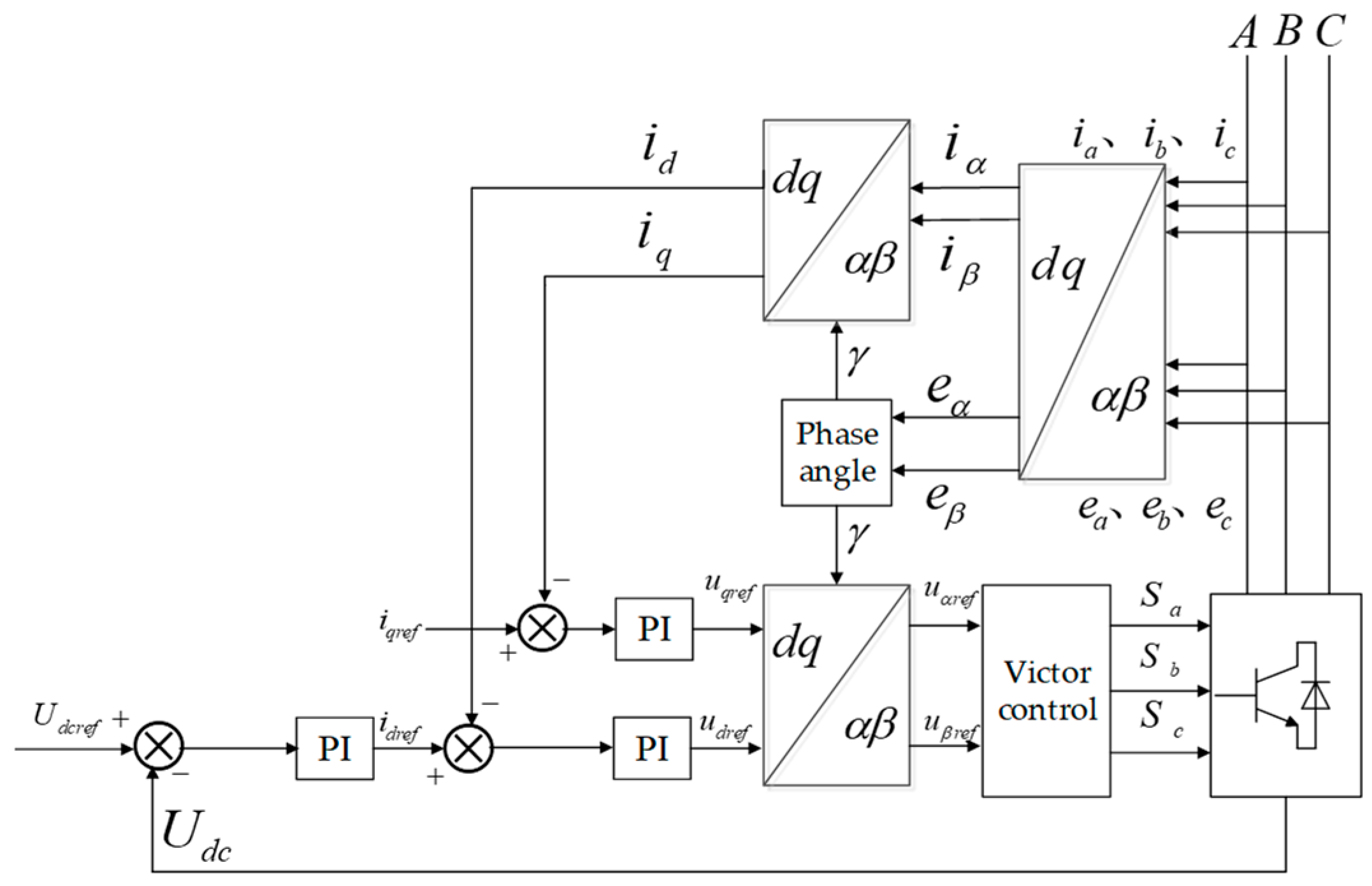
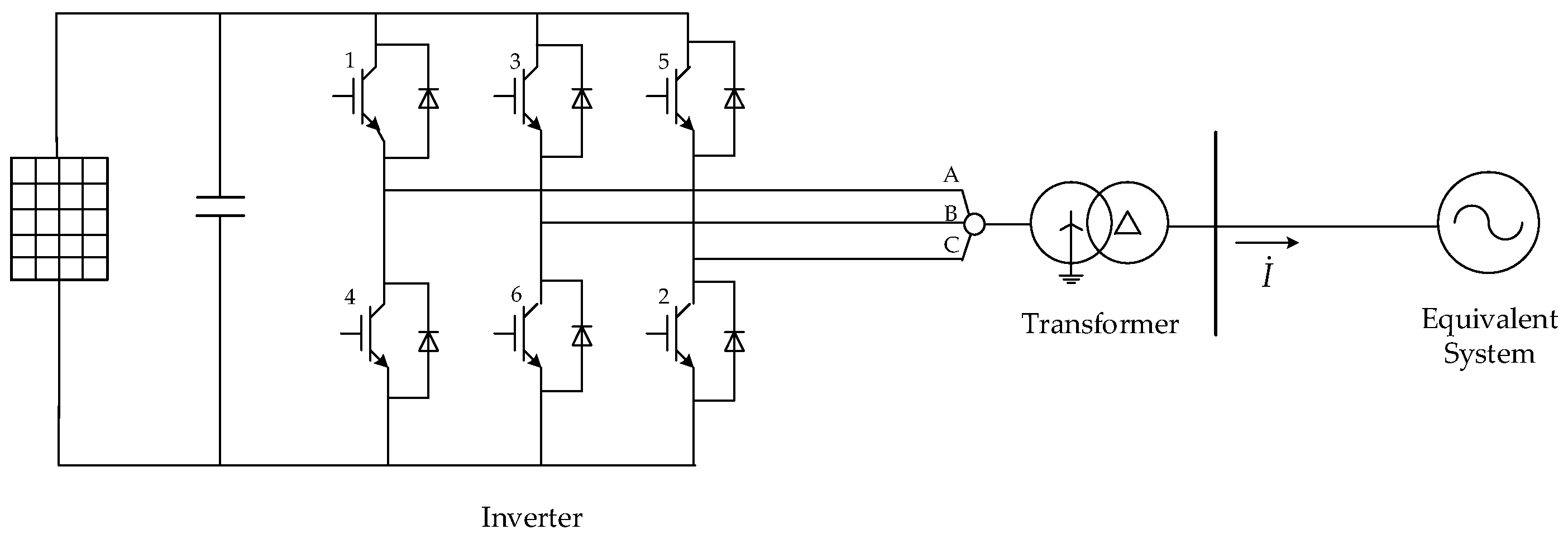

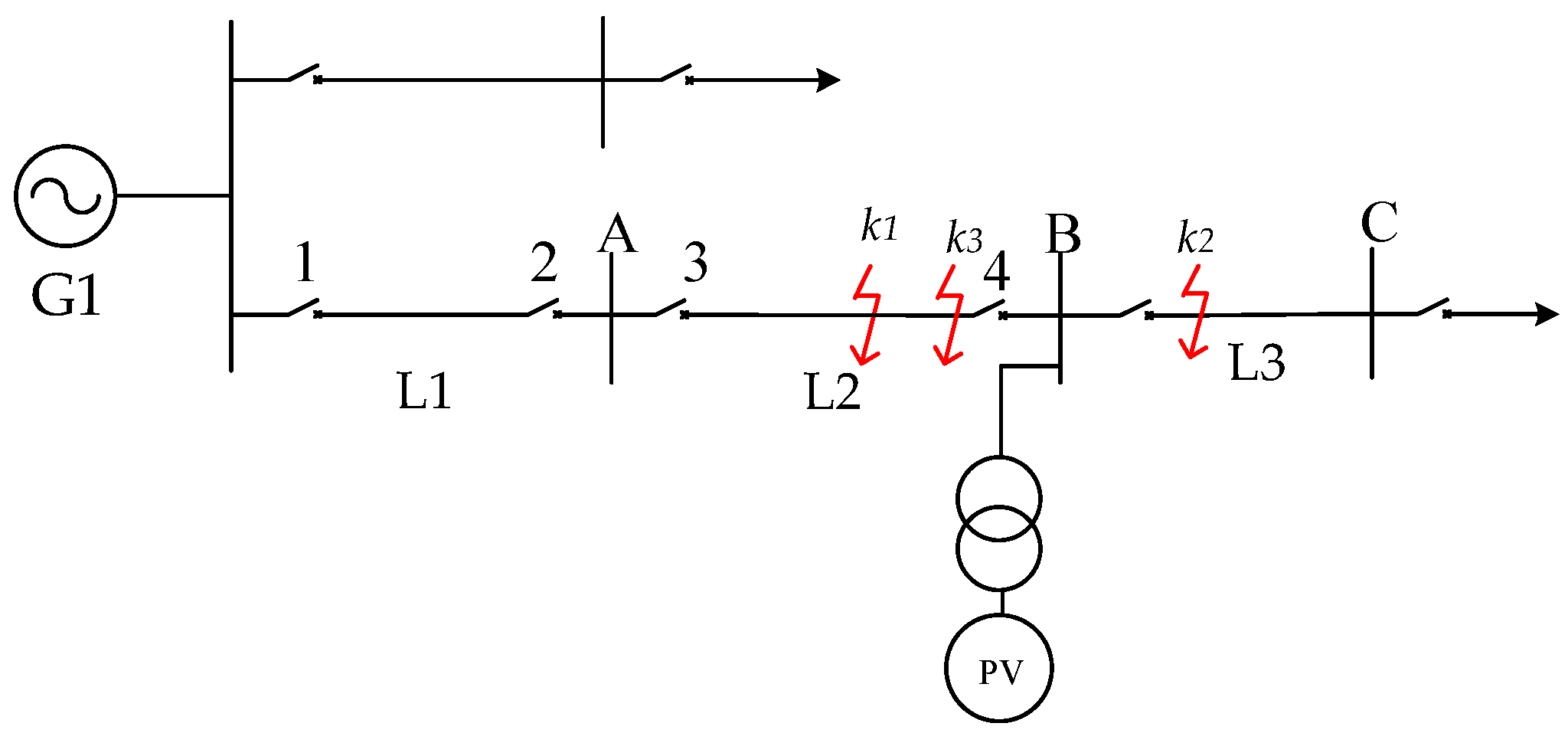
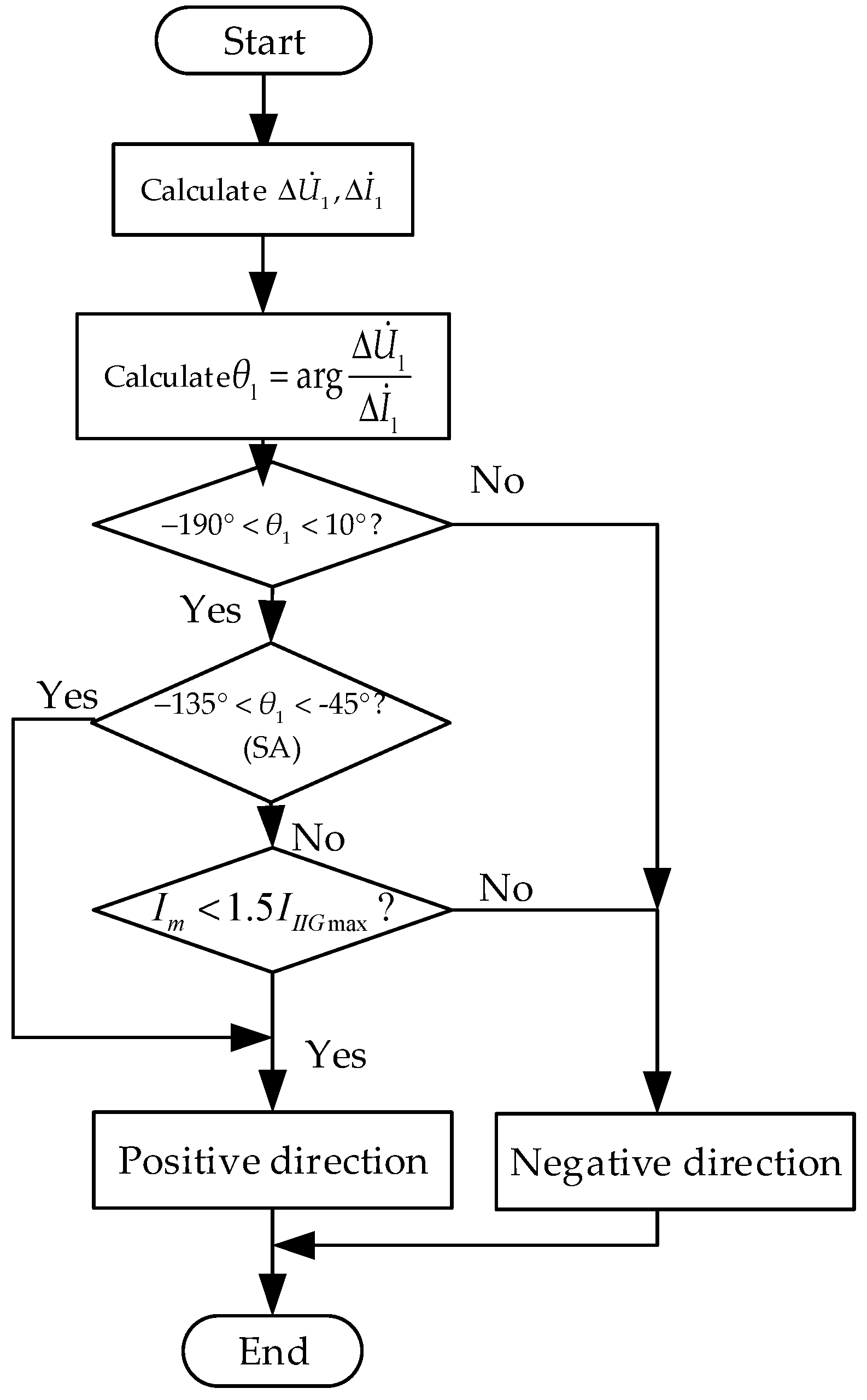




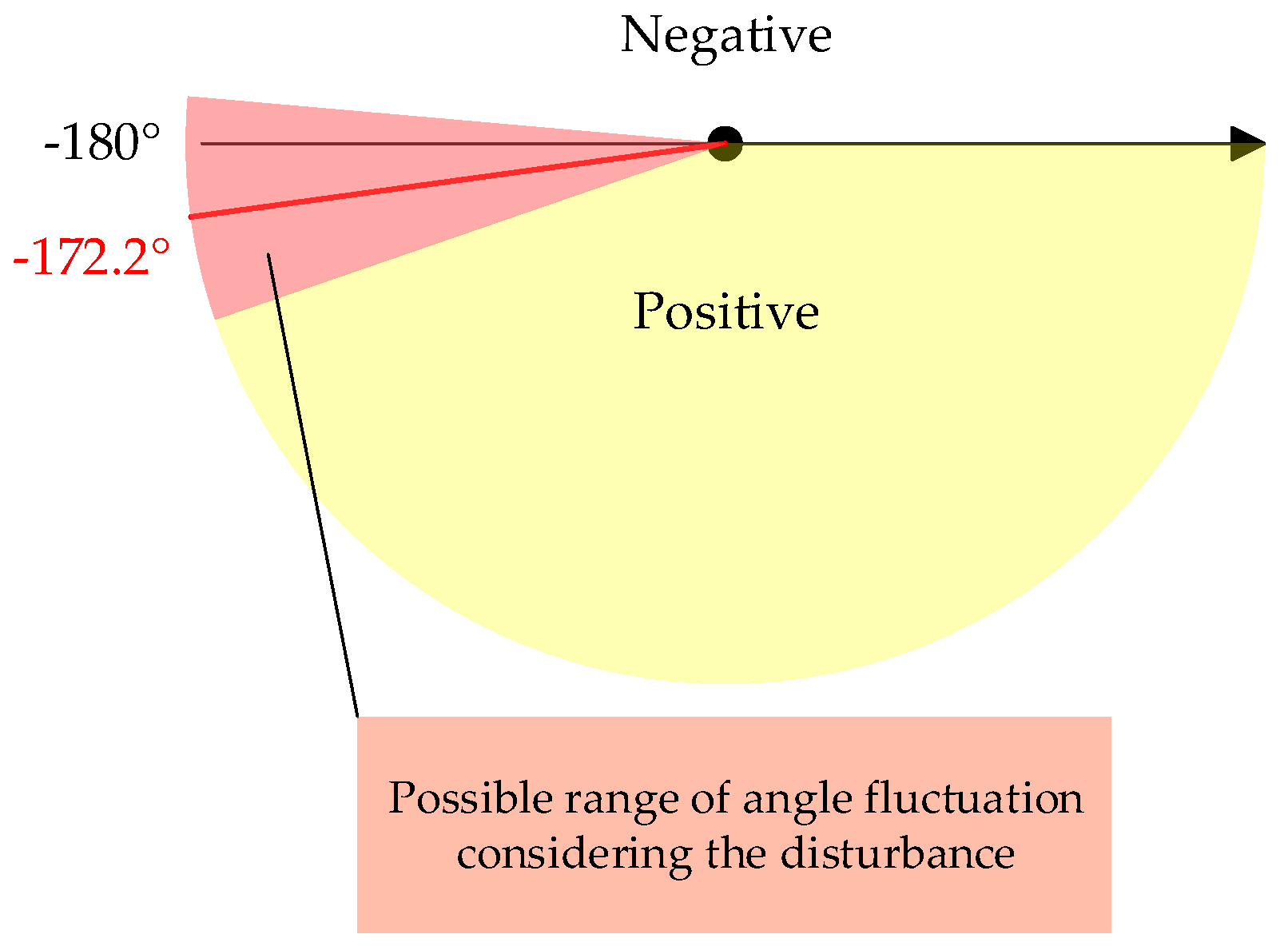
| Fault Location | Fault Type | Relay 3 | Relay 4 | ||||||
|---|---|---|---|---|---|---|---|---|---|
| Fault Current Amplitude/kA | Identification Result | Fault Current Amplitude/kA | Identification Result | ||||||
| k1 | 3ph | −115° | SA | ~ | + | −157.6° | ISA | ) | + |
| 2ph | −113.2° | SA | ~ | + | −153.4° | ISA | ) | + | |
| 2ph-g | −109.7° | SA | ~ | + | −142.7° | ISA | ) | + | |
| k2 | 3ph | −114° | SA | ~ | + | 65.85° | NDA | ~ | - |
| 2ph | −115.1° | SA | ~ | + | 64.64° | NDA | ~ | - | |
| 2ph-g | −111° | SA | ~ | + | 68.79° | NDA | ~ | - | |
© 2019 by the authors. Licensee MDPI, Basel, Switzerland. This article is an open access article distributed under the terms and conditions of the Creative Commons Attribution (CC BY) license (http://creativecommons.org/licenses/by/4.0/).
Share and Cite
Zhu, Y.; Zheng, T.; Wang, M.; Zhao, H.; Wang, X. An Improved Directional Relay Adapted to a Distribution Network with IIG Integration. Energies 2019, 12, 3345. https://doi.org/10.3390/en12173345
Zhu Y, Zheng T, Wang M, Zhao H, Wang X. An Improved Directional Relay Adapted to a Distribution Network with IIG Integration. Energies. 2019; 12(17):3345. https://doi.org/10.3390/en12173345
Chicago/Turabian StyleZhu, Yifan, Tao Zheng, Minghao Wang, Hongcheng Zhao, and Xingguo Wang. 2019. "An Improved Directional Relay Adapted to a Distribution Network with IIG Integration" Energies 12, no. 17: 3345. https://doi.org/10.3390/en12173345




